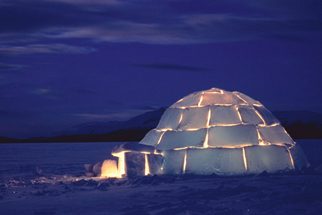The energy properties of snow are vast and remarkable. I will focus on
one effect snow has globally and one application of snow
locally.
The
albedo and radiative properties of snow have the greatest
global impacts. Albedo
is the ratio of light reflected and received by an object. Snow doesn’t have
the same impact as clouds
when regulating radiation and temperature of the planet, but
it still has a great impact.
Snow’s albedo is responsible for a portion of the
reflected global incoming solar radiation.
Albedo
is dependent on snow type,
spectral distribution of the incoming radiation, and
vegetation and surface roughness.12 Fresh snow will
produce the highest albedo.
As snow melts, it is likely the albedo will decrease
from the increase of impurities in older snow. This increases the
absorption and increases the rate of melt in snow. This is not always
certain, however, older snow does not always contain more
impurities.  Spectral
distribution can decrease snow albedo. This is contingent
on the clarity of the atmosphere such as clouds. “Clear-sky diffuse
radiation is focused in the visible part where clean snow
always shows a high reflectance.”13 Vegetation and
surface roughness also have effects. Canopy cover, such
as forests, can lower the albedo along with mountainous
regions and large surface areas. This decrease in
albedo is primarily contributed to the patchiness of the snow surface.
Spectral
distribution can decrease snow albedo. This is contingent
on the clarity of the atmosphere such as clouds. “Clear-sky diffuse
radiation is focused in the visible part where clean snow
always shows a high reflectance.”13 Vegetation and
surface roughness also have effects. Canopy cover, such
as forests, can lower the albedo along with mountainous
regions and large surface areas. This decrease in
albedo is primarily contributed to the patchiness of the snow surface.
Snow becomes increasingly interesting when looking at
its emissivity in the thermal spectrum. “It absorbs all
the long-wave radiation emitted by the atmosphere or by the
surrounding obstacles and emits the maximum thermal
radiation allowed by its surface temperature.”14 The albedo
and emissivity are the cause for the rapid cooling of
continental regions in winter.
The
outstanding properties of snow allow accumulation to be
practically applied to life (other than for consumption and
crop sustenance). Probably
 the most
recognized is an igloo, a snow
shelter native to northern North America. An igloo is a
small structure made from snow pack. It is a hemisphere
with a small entrance protruding from
the front. The
snow operates as insulation between the occupant and the
outside elements. The
porous properties of snow and the shape of the igloo allow
for a warmer climate with proper circulation. The climate is not the same
as a heated, modern western home. It is to protect
from severe elements such as temperatures at -50˚F and
blowing wind and snow.
the most
recognized is an igloo, a snow
shelter native to northern North America. An igloo is a
small structure made from snow pack. It is a hemisphere
with a small entrance protruding from
the front. The
snow operates as insulation between the occupant and the
outside elements. The
porous properties of snow and the shape of the igloo allow
for a warmer climate with proper circulation. The climate is not the same
as a heated, modern western home. It is to protect
from severe elements such as temperatures at -50˚F and
blowing wind and snow.
There
are many
more properties of snow relating to energy. The albedo and
radiative properties are examples. The igloo is one
example of the applications of snow. Other major
applications are for drinking water and crops. Runoff from the
Colorado Rockies supplies water for a large number of people
and farms. The
properties, applications and contributions of snow are
seemingly endless.
| Continue
to Conclusions and Uncertainty Home |